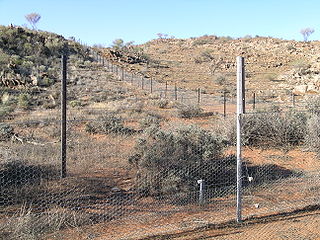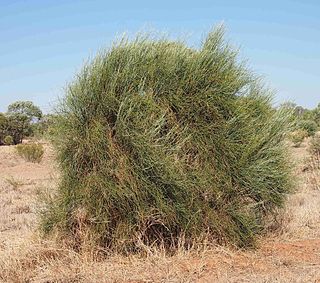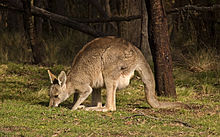
Overgrazing occurs when plants are exposed to intensive grazing for extended periods of time, or without sufficient recovery periods. It can be caused by either livestock in poorly managed agricultural applications, game reserves, or nature reserves. It can also be caused by immobile, travel restricted populations of native or non-native wild animals.

A herbivore is an animal anatomically and physiologically adapted to eating plant material, for example foliage or marine algae, for the main component of its diet. As a result of their plant diet, herbivorous animals typically have mouthparts adapted to rasping or grinding. Horses and other herbivores have wide flat teeth that are adapted to grinding grass, tree bark, and other tough plant material.

An epiphyte is a plant or plant-like organism that grows on the surface of another plant and derives its moisture and nutrients from the air, rain, water or from debris accumulating around it. The plants on which epiphytes grow are called phorophytes. Epiphytes take part in nutrient cycles and add to both the diversity and biomass of the ecosystem in which they occur, like any other organism. They are an important source of food for many species. Typically, the older parts of a plant will have more epiphytes growing on them. Epiphytes differ from parasites in that they grow on other plants for physical support and do not necessarily affect the host negatively. An organism that grows on another organism that is not a plant may be called an epibiont. Epiphytes are usually found in the temperate zone or in the tropics. Epiphyte species make good houseplants due to their minimal water and soil requirements. Epiphytes provide a rich and diverse habitat for other organisms including animals, fungi, bacteria, and myxomycetes.

A grassland is an area where the vegetation is dominated by grasses (Poaceae). However, sedge (Cyperaceae) and rush (Juncaceae) can also be found along with variable proportions of legumes, like clover, and other herbs. Grasslands occur naturally on all continents except Antarctica and are found in most ecoregions of the Earth. Furthermore, grasslands are one of the largest biomes on Earth and dominate the landscape worldwide. There are different types of grasslands: natural grasslands, semi-natural grasslands, and agricultural grasslands. They cover 31–69% of the Earth's land area.

Energy flow is the flow of energy through living things within an ecosystem. All living organisms can be organized into producers and consumers, and those producers and consumers can further be organized into a food chain. Each of the levels within the food chain is a trophic level. In order to more efficiently show the quantity of organisms at each trophic level, these food chains are then organized into trophic pyramids. The arrows in the food chain show that the energy flow is unidirectional, with the head of an arrow indicating the direction of energy flow; energy is lost as heat at each step along the way.

In agriculture, grazing is a method of animal husbandry whereby domestic livestock are allowed outdoors to free range and consume wild vegetations in order to convert the otherwise indigestible cellulose within grass and other forages into meat, milk, wool and other animal products, often on land that is unsuitable for arable farming.

Kelp forests are underwater areas with a high density of kelp, which covers a large part of the world's coastlines. Smaller areas of anchored kelp are called kelp beds. They are recognized as one of the most productive and dynamic ecosystems on Earth. Although algal kelp forest combined with coral reefs only cover 0.1% of Earth's total surface, they account for 0.9% of global primary productivity. Kelp forests occur worldwide throughout temperate and polar coastal oceans. In 2007, kelp forests were also discovered in tropical waters near Ecuador.
Ecological facilitation or probiosis describes species interactions that benefit at least one of the participants and cause harm to neither. Facilitations can be categorized as mutualisms, in which both species benefit, or commensalisms, in which one species benefits and the other is unaffected. This article addresses both the mechanisms of facilitation and the increasing information available concerning the impacts of facilitation on community ecology.

A lake ecosystem or lacustrine ecosystem includes biotic (living) plants, animals and micro-organisms, as well as abiotic (non-living) physical and chemical interactions. Lake ecosystems are a prime example of lentic ecosystems, which include ponds, lakes and wetlands, and much of this article applies to lentic ecosystems in general. Lentic ecosystems can be compared with lotic ecosystems, which involve flowing terrestrial waters such as rivers and streams. Together, these two ecosystems are examples of freshwater ecosystems.

An urchin barren is commonly defined as an urchin-dominated area with little or no kelp. Urchin grazing pressure on kelp is a direct and observable cause of a "barren" area. However, determining which factors contribute to shifting a kelp bed to an urchin barren is a complex problem and remains a matter of debate among scientists.
Trophic cascades are powerful indirect interactions that can control entire ecosystems, occurring when a trophic level in a food web is suppressed. For example, a top-down cascade will occur if predators are effective enough in predation to reduce the abundance, or alter the behavior of their prey, thereby releasing the next lower trophic level from predation.

Conservation grazing or targeted grazing is the use of semi-feral or domesticated grazing livestock to maintain and increase the biodiversity of natural or semi-natural grasslands, heathlands, wood pasture, wetlands and many other habitats. Conservation grazing is generally less intensive than practices such as prescribed burning, but still needs to be managed to ensure that overgrazing does not occur. The practice has proven to be beneficial in moderation in restoring and maintaining grassland and heathland ecosystems. Conservation or monitored grazing has been implemented into regenerative agriculture programs to restore soil and overall ecosystem health of current working landscapes. The optimal level of grazing and grazing animal will depend on the goal of conservation. Different levels of grazing, alongside other conservation practices, can be used to induce desired results.

The feral goat is the domestic goat when it has become established in the wild. Feral goats occur in many parts of the world.

Browsing is a type of herbivory in which a herbivore feeds on leaves, soft shoots, or fruits of high-growing, generally woody plants such as shrubs. This is contrasted with grazing, usually associated with animals feeding on grass or other lower vegetations. Alternatively, grazers are animals eating mainly grass, and browsers are animals eating mainly non-grasses, which include both woody and herbaceous dicots. In either case, an example of this dichotomy are goats and sheep.

An autotroph is an organism that produces complex organic compounds using carbon from simple substances such as carbon dioxide, generally using energy from light (photosynthesis) or inorganic chemical reactions (chemosynthesis). They convert an abiotic source of energy into energy stored in organic compounds, which can be used by other organisms. Autotrophs do not need a living source of carbon or energy and are the producers in a food chain, such as plants on land or algae in water. Autotrophs can reduce carbon dioxide to make organic compounds for biosynthesis and as stored chemical fuel. Most autotrophs use water as the reducing agent, but some can use other hydrogen compounds such as hydrogen sulfide.

Capparis anomala is a species of flowering plant, commonly called warrior bush or broom bush, which is native to Australia.

Feral goats are an invasive animal species in Australia. First arriving in the 18th century with European settlers, feral goat populations originated from escaped domestic individuals. Today, feral goats are found across Australia, where they cause economic and environmental damage through overgrazing and competition with livestock and native marsupials.

A marine habitat is a habitat that supports marine life. Marine life depends in some way on the saltwater that is in the sea. A habitat is an ecological or environmental area inhabited by one or more living species. The marine environment supports many kinds of these habitats.

Marsupial lawns are portions of land where the soil moisture is much higher than in the vegetation surrounding it. These high moisture levels create lawns that attract a large amount of grazing by marsupials. Commonly found in Tasmania, the lawns function as habitats for local animals.

Grazing is a method of feeding in which a herbivore feeds on low-growing plants such as grasses or other multicellular organisms, such as algae. Many species of animals can be said to be grazers, from large animals such as hippopotamuses to small aquatic snails. Grazing behaviour is a type of feeding strategy within the ecology of a species. Specific grazing strategies include graminivory ; coprophagy ; pseudoruminant ; and grazing on plants other than grass, such as on marine algae.


















